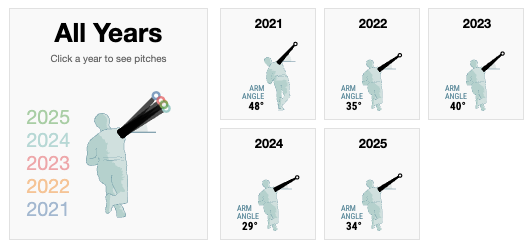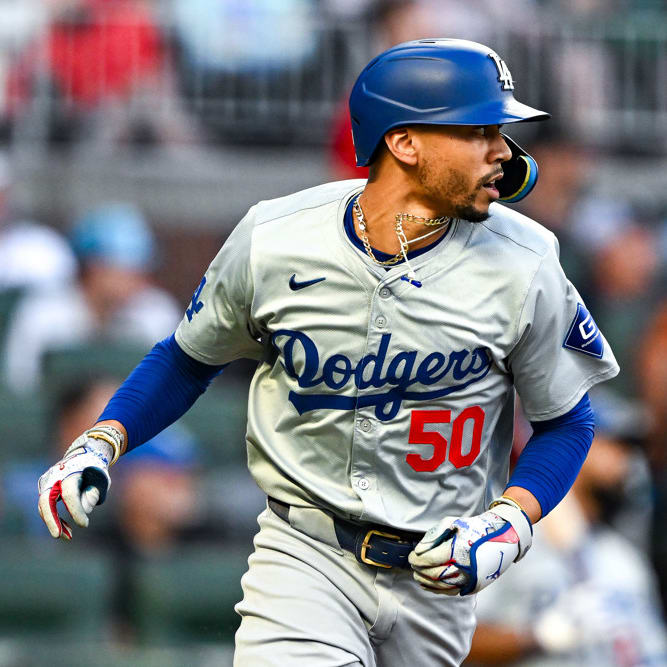This article is part of our Collette Calls series.
Last week, I took a look at some positive and negative changes for hitters. This week, I'll be looking at pitchers looking at some of my favorite skills: fastball velocity, strikeout rate, walk rate and in-zone contact. The goal of this exercise is to find noticeable changes in outcomes or efforts by these pitchers and look into reasons behind those changes in an effort to figure out if we should sell high or to look for buying opportunities if the player is underperforming without any apparent injury.
Fastball velocity
Jordan Hicks: up 3.3 mph
Hicks, out of the bullpen, was one of the hardest throwers we have ever seen in baseball as he hit 105 mph from time to time before his elbow injury. He has since averaged below 100, but his average fastball velocity plunged to 94.6 mph last season with his move to the rotation with the Giants. The league hit .332 off his slower fastballs last season with a .319 xBA, so he and the Giants made some offseason tweaks to increase his velocity that seem to be working, as he has the highest year-over-year increase of any qualified pitcher. Hicks is working from a higher arm slot this season, which has likely helped him recover that velocity, as his sinker is averaging 96.7 mph this season, up from 94.3 mph last season:

We normally see these types of improvements when someone jumps to the pen, as we've seen with Louis Varland this season, but Hicks
Last week, I took a look at some positive and negative changes for hitters. This week, I'll be looking at pitchers looking at some of my favorite skills: fastball velocity, strikeout rate, walk rate and in-zone contact. The goal of this exercise is to find noticeable changes in outcomes or efforts by these pitchers and look into reasons behind those changes in an effort to figure out if we should sell high or to look for buying opportunities if the player is underperforming without any apparent injury.
Fastball velocity
Jordan Hicks: up 3.3 mph
Hicks, out of the bullpen, was one of the hardest throwers we have ever seen in baseball as he hit 105 mph from time to time before his elbow injury. He has since averaged below 100, but his average fastball velocity plunged to 94.6 mph last season with his move to the rotation with the Giants. The league hit .332 off his slower fastballs last season with a .319 xBA, so he and the Giants made some offseason tweaks to increase his velocity that seem to be working, as he has the highest year-over-year increase of any qualified pitcher. Hicks is working from a higher arm slot this season, which has likely helped him recover that velocity, as his sinker is averaging 96.7 mph this season, up from 94.3 mph last season:

We normally see these types of improvements when someone jumps to the pen, as we've seen with Louis Varland this season, but Hicks is doing it in the rotation, even if the outcomes have not yet rewarded his efforts.
Hicks currently has a 6.03 ERA and a 1.45 WHIP through his first seven starts, with just one quality start in those outings. Yet his ERA estimators including a 3.52 xERA and a 3.38 FIP are enticing enough to consider taking a chance on what could be to come. Hicks has two things still working against him: his issues against lefties and his high groundball rate. Groundballs become hits much more frequently than flyballs, and the league has hit .331 off Hicks's sinker since he's been in the rotation because of his 90 percent non-offspeed approach to lefties. Last season, Hicks employed the splitter 25 percent of the time against lefties with good results, but this season, the adjustment has seen it become his least used pitch. The outcomes against lefties have remained constant, with a .290 batting average and a .420-ish slugging percentage against.
Mark Leiter Jr.: up 2.2 mph
Those of you in AL-only leagues like me are always looking for pitching options to replace starters that will not kill us in strikeouts, and Leiter has picked up where he left off with strikeouts this season striking out 36.2 percent of the batters he's faced thus far while picking up two wins and a save to boot. Leiter pitches backwards because he throws his splitter more than any of his other offerings, but his sinker is coming in hotter this season at 93.8 mph, up from 91.6 last season. That sinker was extremely hittable last year as the league hit .386 and homered off that pitch four times, but this season the league has a .200 average (.199 xBA) and has yet to homer off any of the 80 sinkers he's thrown.
The Yankee bullpen is a bit messy these days as Devin Williams continues to sputter, forcing Luke Weaver to step into the primary closer role and allowing Leiter Jr. to assume the role vacated by Weaver. Last year, we saw velocity changes propel Weaver from a mop up guy to one of the more valuable relievers in baseball and Leiter Jr. could do the same thing this season should Williams not be able to get back on the wagon.
Clay Holmes: down 3.9 mph
We knew the velocity would come down with Holmes shifting from the pen to the rotation, but thus far he's successfully navigated the situation, winning four of his seven starts with stellar ratios. Holmes has diversified his portfolio as a starter, going from an extremely heavy usage of his sinker to a five-pitch mix, as he's dusted off his four-seamer while also adding a cutter.
The sinker had a batting average against of .319 last season as a reliever with a .272 xBA, but this season those numbers are .340 and .272, respectively. The more notable drop is that the pitch doesn't have the same whiffiness it had when Holmes was in the pen, as the whiff rate on his sinker has declined from 23 percent to 14 percent this season. Holmes still has not allowed a homer this season and remains one of the toughest pitchers to take deep, even if his extreme groundball rate has dropped into the low 50s as a starter from its peak of 76 percent just three seasons ago.
Strikeout rate
MacKenzie Gore: up 11.6 percent
Gore hasn't changed his arm angle, and his average velocity is right in line with last season, but he has nearly doubled his K-BB% from last year due mainly to the large jump in strikeouts. He has punched out 36.4 percent of the batters he's faced this season without adding any new pitches. What he has done is get ahead more often in counts, which has allowed him to throw more non-fastballs to get keep hitters on the defensive.
The league is hitting .310 (.302 xBA) when Gore throws his four-seamer, but they're swinging and missing more than half the time when he throws his other offerings. The highest expected batting average Gore has on a secondary offering is the .215 for his changeup, while everything else is below .200. His in-zone contact rate has improved for a fourth straight season, yet he has won but two of his eight starts for the struggling Nationals despite a 3.33 ERA and 1.15 WHIP. Simply put, Gore is putting out some serious younger Blake Snell vibes these days.
Andrew Abbott: up 9.6 percent
Abbott has raised his arm slot five degrees this season from his previous seasons and has added a rarely-used cutter, but this early surge in strikeouts appears to be more matchup-based than founded in any process changes. Abbott has faced the Pirates, Orioles, Rockies and Cardinals over four starts, with 11 of his 23 strikeouts coming in one start at Baltimore.
He has been very tough to hit outside of the one start in Denver, but there are no obvious substantive changes which lead me to believe this is a new version of Abbott. His velocity is even down from last season. This would be one of those situations where I would be looking to market the early 2-0 record 2.84 ERA before things heat up in the Cincinnati biosphere.
Ryan Pressly: down 14.5 percent
Pressly had his red flags coming into the season, but those were overshadowed by the news he was going to be the primary closer for his new team in Chicago. He has struggled out of the gate, walking more batters than he's struck out, but yet has still managed four saves along with two wins and a 2.08 ERA that is built on a shaky foundation. Pressly is still a kitchen sink reliever, throwing five different offerings, but he's now struggling to find the zone and batters are simply laying off the curveball, which had been an elite chase pitch for Pressly until this season.
Pressly has been fighting through a knee issue which has no doubt impacted his ability to execute his pitches as he wishes to, so hopefully the recent fluid drain can help him get back on track. The next time he strikes out multiple hitters in an outing this season will be the first, and he has pitched all of five innings without a save since the middle of April. This doesn't appear to be a situation where Pressly has a clear path to 15 saves but more like one where the club looks to find an outside option to take them to the finish line.
Walk Rate
Jose Alvarado: down 6.8 percent
This is huge! Alvarado has always had incredibly nasty stuff, but his walk rate, even at its best, was in the bottom 20th percentile in every stage of his career. This was why the Phillies went out and spent $8 million to get Jordan Romano this winter, because they didn't have full faith in Alvarado solving his command problems. They have given him shots at the ninth previously, and he has saved 30 games in the four seasons with Philadelphia before this season. He's been a man possessed this season with the same nasty stuff, but also one with just three walks in 17 innings of work.
The league knows it is going to get a sinker or a cutter over 90 percent of the time from Alvarado, and so far, they've been able to sneak 36 percent of their balls in play safely for hits this season for a guy whose career rate is just below .300. Alvarado is easily the best late-inning option for Rob Thomson while Jordan Romano is still fighting through command issues.
Chris Bassitt: down 5.0 percent
If you listened to the Sleeper and The Bust podcast over the winter, you likely often heard me repeatedly say, "there is value in volume." Bassitt was one of the posterchilds for that message, because his skills brought along strikeouts and double-digit wins even if his ratios were entering the questionable phase in terms of his rosterability in shallower leagues. Bassitt only has two wins through seven starts, but his walk rate has plummeted from 9.2 percent to 4.2 percent this season, giving him a career-best 21.6 percent K-BB% right now. We rarely see a career-best strikeout rate as well as a career best walk rate from a 36-year-old pitcher, but Bassitt has kept hitters on their toes with his 8-pitch repertoire, and improved first pitch strike rate as well as a career-best rate of getting batters to chase pitches out of the zone.
Bassitt's ERA estimators paint a positive picture moving forward, putting him in solid position for a fifth consecutive double-digit winning season. To get there, he needs some more support because a pitcher with a sub 3.00 ERA should have more than two wins in seven starts but the Toronto offense has not yet found its identity.
Bryce Miller: up 6.4 percent
This number was up over eight until I decided to update the information after his no-decision on Monday night before sending this off to the editors. Miller's season walk rate is now 12.8 percent, which is exactly double what it was over the entire of last season, and his problems have centered around controlling his fastball. Miller's previous recipe for success was simple: pound the zone early with fastball and then get hitters to expand their zones, chasing splitters and breaking pitches. Last season, Miller had a 62 percent first-pitch strike rate, and he had a 66 percent rate the season before; that rate is down to 56 percent in 2025. Hitters are forcing Miller to come into the zone and are now making more contact than they did in previous seasons.
Miller's saving grace is he has only allowed two homers in his 34.2 innings of work around these 19 walks, but a flyball pitcher can only walk this tightrope for so long before it blows up in his face. Miller needs to find his fastball command and get back on the high ground in counts, because his ERA could get problematic in a hurry should his home run rate regress to his career norm while the walks are still present.
In-Zone Contact
Garrett Cleavinger: down 11.9 percent
The noise around Edwin Uceta being the closer in waiting in Tampa Bay sure has gotten quiet lately. What comes out of nowhere usually goes away just as quickly, and Uceta has looked nothing like the guy we saw dominate late last summer. Meanwhile, Cleavinger, who struggled last season, looks like Jose Alvarado, as he too is heavily leaning into a sinker/slider approach this season with excellent results.
Cleavinger was previously four-seamer/cutter-heavy, but those two pitches are now his least-used pitches and the league is struggling to adjust to this new version of him so far. Cleavinger has punched out 17 batters in 12.1 innings of work and has taken his in-zone contact from a pedestrian 82.5 percent to a more dominating 71.2 percent. He is also showing the best first-pitch strike rate of his career and has greatly improved his swinging strike rate. Pete Fairbanks is in the final year of his deal, and Tampa Bay doesn't look like a team that will be playing meaningful baseball in late September, so if you want to get a heads up on the next closer for the Rays, Cleavinger appears to be blazing the path previously cleared for lefty closers with the team by Jake McGee.
Nick Pivetta: down 9.5 percent
My perpetual fantasy kryptonite is finally pitching up to his potential, with a 5-1 record and a 2.01 ERA through seven starts. Of course, I have zero shares of Pivetta in the five leagues where I had a chance to draft him this season. The only substantive change Pivetta has made in his repertoire is to shelve his slider, but his overall approach is nearly identical to last season as is his velocity and arm angle. We could perhaps chalk this up to moving to a new league and the unfamiliarity of National League hitters with his stuff, because his only bad outing came against the Cubs in early April, but he bounched back to defeat them the next time he saw them.
Pivetta has had a tough overall schedule early, but has successfully navigated the choppy waters with some in-zone sorcery. He typically nibbled around the zone, leaning on his riding fastball and plunging curveball to the top and bottom of the zone, but the newness of the National League may be the best way to explain how his in-zone contact rate has dropped from an unseemly 89.2 percent down to a solid 79.7 percent so far this season. His .182 batting average against is one of the best in baseball, and a 2.01 ERA and 0.94 WHIP just makes me more upset I am not realizing these returns on one of my own teams after chasing Pivetta's potential for so many seasons. If Pivetta can continue pitching like this and avoiding the longball which has plagued him for so long in tougher ballparks than Petco, this should be a career year for him.
Tanner Bibee: up 8.4 percent
Bibee is off to a rough start, with a 3-2 record and a 4.26 ERA and 1.32 WHIP through his first seven starts. Many were expecting another step forward after Bibee's stellar sophomore campaign, yet the early returns have been disappointing because the current version of Bibee doesn't quite resemble the 2023-2024 version. Yes, the velocity is still there, but he's now throwing a sinker as his tertiary pitch this season, a pitch which was the least-utilized of his six-pitch mix in 2024. Bibee is now throwing one of his three fastballs (four-seamer, sinker, cutter) 72 percent of the time, which helps explain why his in-zone contact rate has jumped from 80.6 percent to 88.9 percent this season. He is throwing slightly fewer first-pitch strikes than last season, but all these fastballs in the zone have impacted his in-zone contact as well as a swinging strike rate which has plummeted nearly five percentage points.
It's almost as if Bibee and Bassitt did some type of version of Freaky Friday and have switched bodies and outcomes. The other problem with Bibee is the increased fastballs in the zone are leading to homers, as seven of the nine homers he has allowed this season have come off the fastballs and his ERA indicators say he has actually been a bit lucky with where things stand now.










